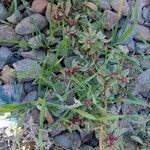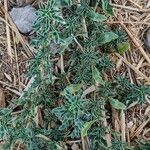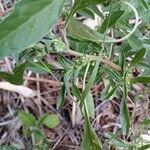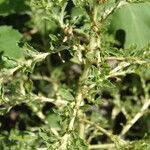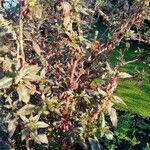Monoecious; stems prostrate, much branched, 2–6 dm; lvs numerous, pale green, oblong to obovate, 1–2 cm, obtuse or rounded, attenuate to a long petiole, often crowded near the branch-tips; fls in short, dense, axillary clusters; bracts about equaling the sep, acuminate, scarcely aristate; sep 4–5, with conspicuous, branching green veins; those of the pistillate fls ovate to oblong, straight, acuminate, unequal; stamens 3; style-branches short, recurved; fr thick-lenticular, 2–2.5 mm, about equaling the longest sep, smooth or nearly so, circumscissile at the middle; seed suborbicular, 1.4–1.7 mm; 2n=32. Native of w. U.S., intr. in our range and common as a weed except in the extreme northeast. (A. graecizans, misapplied)
Stem greenish white, 15-50 cm tall, divaricately branched from base, glabrous. Leaves dense; petiole 0.5-1.5 cm; leaf blade obovate or spatulate to oblong-oblanceolate, 0.5-2.5 cm × 3-10 mm, base cuneate, margin entire, apex obtuse or acute, with a mucro. Flowers clustered at axils, shorter than petioles. Bracts and bracteoles lanceolate, ca. 3 mm, apex acute. Tepals 4(or 5), green, ovate-lanceolate to oblong-lanceolate, 1-2.5 mm, apex acuminate and pointed. Stigmas 3. Utricles ellipsoid, longer than longest perianth segment, ca. 2 mm, circumscissile. Seeds black, slightly shiny, ovoid, ca. 1.5 mm in diam. Fl. Aug-Sep, fr. Sep-Oct. 2n = 32.
A herb. It grows 15-50 cm tall. The stems are greenish white. Stems divided from the base. The leaves are dense and 1-3 cm long by 3-10 mm wide. The leaf base is wedge shaped. The flowers are in clusters in the axils of leaves. The seeds are about 2 mm across.
